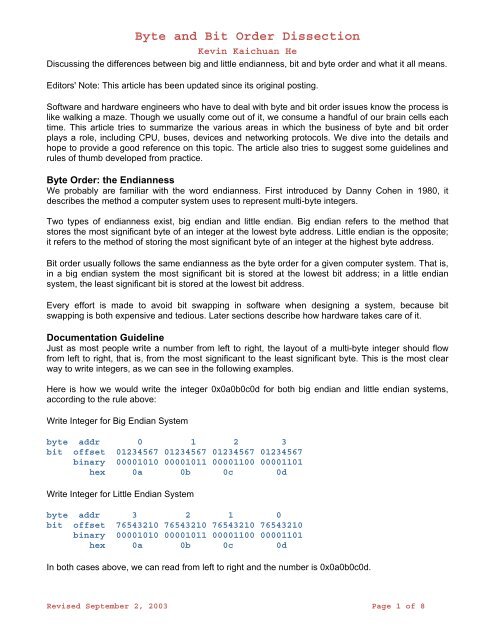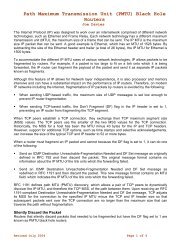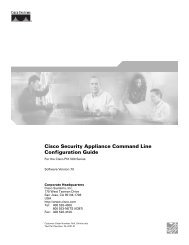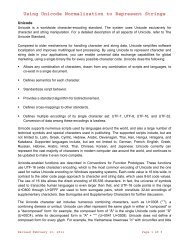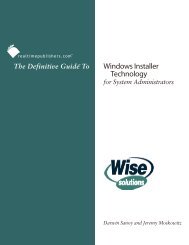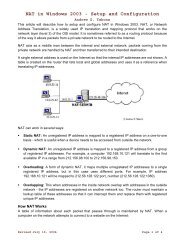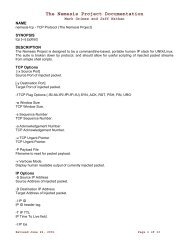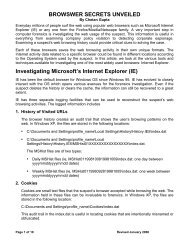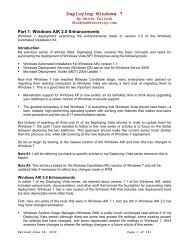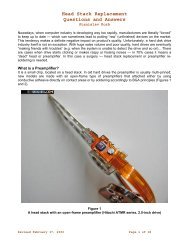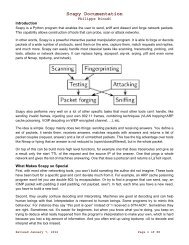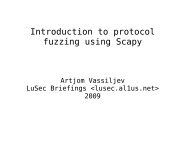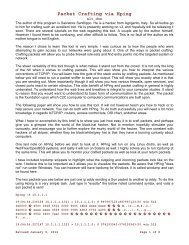Byte and Bit Order Dissection
Byte and Bit Order Dissection
Byte and Bit Order Dissection
You also want an ePaper? Increase the reach of your titles
YUMPU automatically turns print PDFs into web optimized ePapers that Google loves.
<strong>Byte</strong> <strong>and</strong> <strong>Bit</strong> <strong>Order</strong> <strong>Dissection</strong><br />
Kevin Kaichuan He<br />
Discussing the differences between big <strong>and</strong> little endianness, bit <strong>and</strong> byte order <strong>and</strong> what it all means.<br />
Editors' Note: This article has been updated since its original posting.<br />
Software <strong>and</strong> hardware engineers who have to deal with byte <strong>and</strong> bit order issues know the process is<br />
like walking a maze. Though we usually come out of it, we consume a h<strong>and</strong>ful of our brain cells each<br />
time. This article tries to summarize the various areas in which the business of byte <strong>and</strong> bit order<br />
plays a role, including CPU, buses, devices <strong>and</strong> networking protocols. We dive into the details <strong>and</strong><br />
hope to provide a good reference on this topic. The article also tries to suggest some guidelines <strong>and</strong><br />
rules of thumb developed from practice.<br />
<strong>Byte</strong> <strong>Order</strong>: the Endianness<br />
We probably are familiar with the word endianness. First introduced by Danny Cohen in 1980, it<br />
describes the method a computer system uses to represent multi-byte integers.<br />
Two types of endianness exist, big endian <strong>and</strong> little endian. Big endian refers to the method that<br />
stores the most significant byte of an integer at the lowest byte address. Little endian is the opposite;<br />
it refers to the method of storing the most significant byte of an integer at the highest byte address.<br />
<strong>Bit</strong> order usually follows the same endianness as the byte order for a given computer system. That is,<br />
in a big endian system the most significant bit is stored at the lowest bit address; in a little endian<br />
system, the least significant bit is stored at the lowest bit address.<br />
Every effort is made to avoid bit swapping in software when designing a system, because bit<br />
swapping is both expensive <strong>and</strong> tedious. Later sections describe how hardware takes care of it.<br />
Documentation Guideline<br />
Just as most people write a number from left to right, the layout of a multi-byte integer should flow<br />
from left to right, that is, from the most significant to the least significant byte. This is the most clear<br />
way to write integers, as we can see in the following examples.<br />
Here is how we would write the integer 0x0a0b0c0d for both big endian <strong>and</strong> little endian systems,<br />
according to the rule above:<br />
Write Integer for Big Endian System<br />
byte addr 0 1 2 3<br />
bit offset 01234567 01234567 01234567 01234567<br />
binary 00001010 00001011 00001100 00001101<br />
hex 0a 0b 0c 0d<br />
Write Integer for Little Endian System<br />
byte addr 3 2 1 0<br />
bit offset 76543210 76543210 76543210 76543210<br />
binary 00001010 00001011 00001100 00001101<br />
hex 0a 0b 0c 0d<br />
In both cases above, we can read from left to right <strong>and</strong> the number is 0x0a0b0c0d.<br />
Revised September 2, 2003 Page 1 of 8
<strong>Byte</strong> <strong>and</strong> <strong>Bit</strong> <strong>Order</strong> <strong>Dissection</strong><br />
Kevin Kaichuan He<br />
If we do not follow the rule, we might write the number in the following way:<br />
byte addr 0 1 2 3<br />
bit offset 01234567 01234567 01234567 01234567<br />
binary 10110000 00110000 11010000 01010000<br />
As you can see, it's hard to make out what number we're trying to represent.<br />
Simplified Computer System Used in this Article<br />
Without losing generality, a simplified view of the computer system discussed in this article is drawn<br />
below.<br />
CPU, local bus <strong>and</strong> internal memory/cache all are considered to be CPU, because they usually share<br />
the same endianness. Discussion of bus endianness, however, covers only external bus. The CPU<br />
register width, memory word width <strong>and</strong> bus width are assumed to be 32 bits for this article.<br />
Endianness of CPU<br />
The CPU endianness is the byte <strong>and</strong> bit order in which it interprets multi-byte integers from on-chip<br />
registers, local bus, in-line cache, memory <strong>and</strong> so on.<br />
Little endian CPUs include Intel <strong>and</strong> DEC. Big endian CPUs include Motorola 680x0, Sun Sparc <strong>and</strong><br />
IBM (e.g., PowerPC). MIPs <strong>and</strong> ARM can be configured either way.<br />
The CPU endianness affects the CPU's instruction set. Different GNU C toolchains for compiling the C<br />
code ought to be used for CPUs of different endianness. For example, mips-linux-gcc <strong>and</strong> mipsellinux-gcc<br />
are used to compile MIPs code for big endian <strong>and</strong> little endian, respectively.<br />
The CPU endianness also has an impact on software programs if we need to access part of a multibyte<br />
integer. The following program illustrates that situation. If one accesses the whole 32-bit integer,<br />
the CPU endianness is invisible to software programs.<br />
Revised September 2, 2003 Page 2 of 8
<strong>Byte</strong> <strong>and</strong> <strong>Bit</strong> <strong>Order</strong> <strong>Dissection</strong><br />
Kevin Kaichuan He<br />
union {<br />
uint32_t my_int;<br />
uint8_t my_bytes[4];<br />
} endian_tester;<br />
endian_tester et;<br />
et.my_int = 0x0a0b0c0d;<br />
if(et.my_bytes[0] == 0x0a )<br />
printf( "I'm on a big-endian system\n" );<br />
else<br />
printf( "I'm on a little-endian system\n" );<br />
Endianness of Bus<br />
The bus we refer to here is the external bus we showed in the figure above. We use PCI as an<br />
example below. The bus, as we know, is an intermediary component that interconnects CPUs,<br />
devices <strong>and</strong> various other components on the system. The endianness of bus is a st<strong>and</strong>ard for<br />
byte/bit order that bus protocol defines <strong>and</strong> with which other components comply.<br />
Take an example of the PCI bus known as little endian. It implies the following: among the 32<br />
address/data bus line AD [31:0], it expects a 32-bit device <strong>and</strong> connects its most significant data line<br />
to AD31 <strong>and</strong> least significant data line to AD0. A big endian bus protocol would be the opposite.<br />
For a partial word device connected to bus, for example, an 8-bit device, little endian bus-like PCI<br />
specifies that the eight data lines of the device be connected to AD[7:0]. For a big endian bus<br />
protocol, it would be connected to AD[24:31].<br />
In addition, for PCI bus the protocol requires each PCI device to implement a configuration space.<br />
This is a set of configuration registers that have the same byte order as the bus.<br />
Just as all the devices need to follow bus's rules regarding byte/bit endianness, so does the CPU. If a<br />
CPU operates in an endianness different from the bus, the bus controller/bridge usually is the place<br />
where the conversion is performed.<br />
An alert reader nows ask this question, "so what happens if the endianness of the device is different<br />
from the endianness of the bus?" In this case, we need to do some extra work for communication to<br />
occur, which is covered in the next section.<br />
Endianness of Devices<br />
Kevin's Theory #1: When a multi-byte data unit travels across the boundary of two reverse endian<br />
systems, the conversion is made such that memory contiguousness to the unit is preserved.<br />
We assume CPU <strong>and</strong> bus share the same endianness in the following discussion. If the endianness<br />
of a device is the same as that of CPU/bus, then no conversion is needed.<br />
In the case of different endianness between the device <strong>and</strong> the CPU/bus, we offer two solutions here<br />
from a hardware wiring point of view. We assume CPU/bus is little endian <strong>and</strong> the device is big endian<br />
in the following discussion.<br />
Word Consistent Approach<br />
In this approach, we swap the entire 32-bit word of the device data line. We represent the data line of<br />
device as D[0:31], where D(0) stores the most significant bit, <strong>and</strong> bus line as AD[31:0]. This approach<br />
Revised September 2, 2003 Page 3 of 8
<strong>Byte</strong> <strong>and</strong> <strong>Bit</strong> <strong>Order</strong> <strong>Dissection</strong><br />
Kevin Kaichuan He<br />
suggests wiring D(i) to AD(31-i), where i = 0, ..., 31. Word Consistent means the semantic of the<br />
whole word is preserved.<br />
To illustrate, the following code represents a 32-bit descriptor register in a big endian NIC card:<br />
After applying the Word Consistent swap (wiring D[0:31] to AD[31:0]) , the result in the CPU/bus is:<br />
Notice that it automatically is little endian for CPU/bus. No software byte or bit swapping is needed.<br />
The above example is for those simple cases where data does not cross a 32-bit memory boundary.<br />
Now, let's take a look at a case where it does. In the following code, vlan[0:24] has a value of<br />
0xabcdef <strong>and</strong> crosses a 32-bit memory boundary.<br />
After the Word Consistent swap, the result is:<br />
Do you see what happened? The vlan field has been broken into two noncontiguous memory spaces:<br />
bytes[1:0] <strong>and</strong> byte(7). It violates Kevin's Theory #1, <strong>and</strong> we are not able to define a nice C structure<br />
to access the in-contiguous vlan fields.<br />
Therefore, the Word Consistent solution works only for data within word boundaries <strong>and</strong> does not<br />
work for data that may cross a word boundary. The second approach solves this problem for us.<br />
<strong>Byte</strong> Consistent Approach<br />
Revised September 2, 2003 Page 4 of 8
<strong>Byte</strong> <strong>and</strong> <strong>Bit</strong> <strong>Order</strong> <strong>Dissection</strong><br />
Kevin Kaichuan He<br />
In this approach, we do not swap bytes, but we do swap the bits within each byte lane (bit at device<br />
bit-offset i goes to bus bit-offset (7-i), where i=0...7) in hardware wiring. <strong>Byte</strong> Consistent means the<br />
semantic of the byte is preserved.<br />
After applying this method, the big endian NIC device value in above results in this CPU/bus value:<br />
Now, the three bytes of the vlan field are in contiguous memory space, <strong>and</strong> the content of each byte<br />
reads correctly. But this result still looks messy in byte order. However, because we now occupy a<br />
contiguous memory space, let the software do a byte swap for this 5-byte data structure. We get the<br />
following result:<br />
We see that software byte swapping needs to be performed as the second procedure in this<br />
approach. <strong>Byte</strong> swapping is affordable in software, unlike bit swapping.<br />
Kevin's Theory #2: In a C structure that contains bit fields, if field A is defined in front of field B, then<br />
field A always occupies a lower bit address than field B.<br />
Now that everything is sorted out nicely, we can define the C structure as the following to access the<br />
descriptor in the NIC:<br />
struct nic_tag_reg {<br />
uint64_t vlan:24 __attribute__((packed));<br />
uint64_t rx :6 __attribute__((packed));<br />
uint64_t tag :10 __attribute__((packed));<br />
};<br />
Endianness of Network Protocols<br />
The endianness of network protocols defines the order in which the bits <strong>and</strong> bytes of an integer field<br />
of a network protocol header are sent <strong>and</strong> received. We also introduce a term called wire address<br />
here. A lower wire address bit or byte always is transmitted <strong>and</strong> received in front of a higher wire<br />
address bit or byte.<br />
In fact, for network endianness, it is a little different than what we have seen so far. Another factor is<br />
in the picture: the bit transmission/reception order on the physical wire. Lower layer protocols, such as<br />
Ethernet, have specifications for bit transmission/reception order, <strong>and</strong> sometimes it can be the reverse<br />
of the upper layer protocol endianness. We look at this situation in our examples.<br />
The endianness of NIC devices usually follow the endianness of the network protocols they support,<br />
so it could be different from the endianness of the CPU on the system. Most network protocols are big<br />
endian; here we take Ethernet <strong>and</strong> IP as examples.<br />
Revised September 2, 2003 Page 5 of 8
<strong>Byte</strong> <strong>and</strong> <strong>Bit</strong> <strong>Order</strong> <strong>Dissection</strong><br />
Kevin Kaichuan He<br />
Endianness of Ethernet<br />
Ethernet is big endian. This means the most significant byte of an integer field is placed at a lower<br />
wire byte address <strong>and</strong> transmitted/received in front of the least significant byte. For example, the<br />
protocol field with a value of 0x0806(ARP) in the Ethernet header has a wire layout like this:<br />
wire byte offset: 0 1<br />
hex : 08 06<br />
Notice that the MAC address field of the Ethernet header is considered as a string of characters, in<br />
which case the byte order does not matter. For example, a MAC address 12:34:56:78:9a:bc has a<br />
layout on the wire like that shown below, <strong>and</strong> byte 12 is transmitted first.<br />
<strong>Bit</strong> Transmission/Reception <strong>Order</strong><br />
The bit transmission/reception order specifies how the bits within a byte are transmitted/received on<br />
the wire. For Ethernet, the order is from the least significant bit (lower wire address offset) to the most<br />
significant bit (higher wire address offset). This apparently is little endian. The byte order remains the<br />
same as big endian, as described in early section. Therefore, here we see the situation where the<br />
byte order <strong>and</strong> the bit transmission/reception order are the reverse.<br />
The following is an illustration of Ethernet bit transmission/reception order:<br />
We see from this that the group (multicast) bit, the least significant bit of the first byte, appeared as<br />
the first bit on the wire. Ethernet <strong>and</strong> 802.3 hardware behave consistently with the bit<br />
transmission/reception order above.<br />
In this case, where the protocol byte order <strong>and</strong> the bit transmission/reception order are different, the<br />
NIC must convert the bit transmission/reception order from/to the host(CPU) bit order. By doing so,<br />
the upper layers do not have to worry about bit order <strong>and</strong> need only to sort out the byte order. In fact,<br />
this is another form of the <strong>Byte</strong> Consistent approach, where byte semantics are preserved when data<br />
travels across different endian domains.<br />
The bit transmission/reception order generally is invisible to the CPU <strong>and</strong> software, but is important to<br />
hardware considerations such as the serdes (serializer/deserializer) of PHY <strong>and</strong> the wiring of NIC<br />
device data lines to the bus.<br />
Parsing Ethernet Header in Software<br />
For either endianness, the Ethernet header can be parsed by software with the C structure below:<br />
Revised September 2, 2003 Page 6 of 8
<strong>Byte</strong> <strong>and</strong> <strong>Bit</strong> <strong>Order</strong> <strong>Dissection</strong><br />
Kevin Kaichuan He<br />
struct ethhdr<br />
{<br />
unsigned char h_dest[ETH_ALEN];<br />
unsigned char h_source[ETH_ALEN];<br />
unsigned short h_proto;<br />
};<br />
The h_dest <strong>and</strong> h_source fields are byte arrays, so no conversion is needed. The h_proto field here<br />
is an integer, therefore a ntohs() is needed before the host accesses this field, <strong>and</strong> htons() is needed<br />
before the host fills up this field.<br />
Endianness of IP<br />
IP's byte order also is big endian. The bit endianness of IP inherits that of the CPU, <strong>and</strong> the NIC takes<br />
care of converting it from/to the bit transmission/reception order on the wire.<br />
For big endian hosts, IP header fields can be accessed directly. For little endian hosts, which are most<br />
PCs in the world (x86), byte swap needs to be be performed in software for the integer fields in the IP<br />
header.<br />
Below is the structure of iphdr from the Linux kernel. We use ntohs() before reading integer fields <strong>and</strong><br />
htons() before writing them. Essentially, these two functions do nothing for big endian hosts <strong>and</strong><br />
perform byte swapping for little endian hosts.<br />
struct iphdr {<br />
#if defined(__LITTLE_ENDIAN_BITFIELD)<br />
__u8 ihl:4,<br />
version:4;<br />
#elif defined (__BIG_ENDIAN_BITFIELD)<br />
__u8 version:4,<br />
ihl:4;<br />
#else<br />
#error "Please fix "<br />
#endif<br />
__u8 tos;<br />
__u16 tot_len;<br />
__u16 id;<br />
__u16 frag_off;<br />
__u8 ttl;<br />
__u8 protocol;<br />
__u16 check;<br />
__u32 saddr;<br />
__u32 daddr;<br />
/*The options start here. */<br />
};<br />
Take a look at some interesting fields in the IP header:<br />
version <strong>and</strong> ihl fields: According to IP st<strong>and</strong>ard, version is the most significant four bits of the first<br />
byte of an IP header. ihl is the least significant four bits of the first byte of the IP header.<br />
Revised September 2, 2003 Page 7 of 8
<strong>Byte</strong> <strong>and</strong> <strong>Bit</strong> <strong>Order</strong> <strong>Dissection</strong><br />
Kevin Kaichuan He<br />
There are two methods to access these fields. Method 1 directly extracts them from the data. If ver_ihl<br />
holds the first byte of the IP header, then (ver_ihl & 0x0f) gives the ihl field <strong>and</strong> (ver_ihl > > 4) gives<br />
the version field. This applies for hosts with either endianness.<br />
Method 2 is to define the structure as above, then access these fields from the structure itself. In the<br />
above structure, if the host is little endian, then we define ihl before version; if the host is big endian,<br />
we define version before ihl. If we apply Kevin's Theory #2 here that an earlier defined field always<br />
occupies a lower memory address, we find that the above definition in C structure fits the IP st<strong>and</strong>ard<br />
pretty well.<br />
saddr <strong>and</strong> daddr fields: these two fields can be treated as either byte or integer arrays. If they are<br />
treated as byte arrays, there is no need to do endianness conversion. If they are treated as integers,<br />
then conversions need to be performed as needed. Below is a function with integer interpretation:<br />
/* dot2ip - convert a dotted decimal string into an<br />
* IP address<br />
*/<br />
uint32_t dot2ip(char *pdot)<br />
{<br />
uint32_t i,my_ip;<br />
my_ip=0;<br />
for (i=0; i


